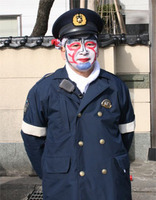

Total:35items
- Folk Performing Art (16)
- Kenbai: Sword Dance
- Kirin Shishimai: Kylin Lion Dance
- Yoshiwa Taiko Odori: Yoshiwa Drum Dance
- Omiya Odori: Omiya Dance
- Tsurusaki-Odori festival
- Omi Take-no-karakai (Tug-of-wars with bamboo)
- Nakizumo: Crying Baby Sumo
- Ryugasaki Tsukumai:Ryugasaki Acrobatic Performance
- Mikawa Manzai
- Esashi Oiwake: Esashi Folk Singing
- Ayado Yonenbutsu and Bon festival dance
- Occhi-no-Ohinagayu (rice porridge offering for the Doll's Festival in Occhi)
- Hanatori-odori Dance (Masuda area)
- Kaga-manzai
- Rice Planting festival of Tsutsukowake Shrine
- Edo sato kagura: Edo folk dance for entertaining god
- Kabuki (2)
- Noh & Kyogen (1)
- Festival (10)
- Ritual & Ceremony (2)
- Puppet Play (2)
- Folk technology (2)

 |
|
 《Feature》
《Feature》“Omi Take-no-karakai” is a very unique annual event in Japan held in the mid-January to celebrate Lunar New Year’s Day, which has been inherited since the Edo Period (17c), about 300 years ago, in Higashi-machi and Nishi-machi (East Town and West Town) of Omi, Itoigawa City, Niigata Prefecture.
When a new year begins, Omi area, divided into Higashi-machi (east town) and Nishi-machi (west town), starts preparation for Take-no-karakai to be held on January 15th. At the event, the two town teams consisting of mainly young men with special ‘kumadori’ make-up energetically fight by hauling two 13-14-meter bamboos from both sides. The fights are followed by ‘Sai-no-kami-yaki’, or a bonfire ceremony by burning New Year’s decorations on the shore to pray to a local guardian deity Sai-no-kami for good health of the people, rich harvest, and good haul during the year. It is believed that this event is originated from a folk belief with an aim to pray for rich harvest, warding off bad luck and bringing good luck, and well-being of families.
Let’s see how the Omi Take-no-karakai proceeds in more detail, from its preparation through the fights to the end.
1. Omatsu-tori (Collecting New Year’s decorations)
Firstly, on January 7th, the elementary and junior high school students in the eastern and western Omi towns visit local houses in their areas respectively to collect the used New Year’s decorations such as kadomatsu or matsu-kazari (pine-branch ornaments decorated at entrance and other points) and shime-nawa (sacred screwed straw ropes with white paper strips). On the morning of the 15th, the collected decorations are carried to the shore and built up high, which are called “Omatsu-san” (sacred pine and other decorations for the New Year’s Day). The more decorations are believed to be better to delight the deity.
2. Take-kiri (Cutting down bamboos)
Around January 10th, young men in the eastern and western Omi towns selects and cuts down young bamboos considered as yorishiro, or an object to which the local guardian deity Sai-no-kami descends from the Heaven, and thus the bamboos are supposed to be a sacred object that decides the winner at the coming games. From the cut bamboos, four bamboos are picked up and prepared for Kazari-take (banner bamboo), Isami-take (vanguard bamboo), Awase-take (the second-fight bamboo to be combined), and Saiku-take (decoration bamboo).
3. Preparation of Kazari-take (banner bamboo)
Kazari-take (banner bamboos) are decorated a few days before the event and placed in front of the both Higashi-machi and Nishi-machi encampments on the morning of January 15th prior to the bamboo-tug fights. The bamboo, to which Saino-kami deity is believed to descend from the Heaven, is beautifully decorated with offerings to the deity such as streamers, folding fans, plaited colorful paper streamers, white-stripped sacred twisted straws, and small sake barrels.
4. Take-no-karakai (Bamboo tug-of-war)
At noon of 15th, Take-no-karakai finally begins. Young men from both the eastern and western Omi towns wear traditional Japanese festival outfits Happi, headbands hachimaki, and sacred twisted rope shimenawa around their waist, and put on their faces special make-up kumadori. Firstly, they carry Isami-take (vanguard bamboo) to the central place (the former entrance to an approach to Omi Shrine) and stand them there, and dance around the bamboos, singing a traditional local folk song “Sagi-no-cho” in order to raise their morale. Secondly, turning the bottom part of Isami-take ahead, the two teams step forward from both sides. When the central parts of the two bamboos come crossing the teams, triggered by the team member’s jumping at the crossed part, begin to play bamboo tug-of-war, holding the two bamboos together. Two tugs with ‘Isami-take’ and one tug with Awase-take, totally 3 tugs of bamboos take place. The event culminated athe final tug with Awase-take, added with young team members’ more excitement, and the enthusiastic atmosphere of the whole area.
5. Kazari-take-naoshi (Clearing up banner bamboos)
After the final tug-of-war, both of the two teams back to their own encampment and put down their banner bamboos, which is termed “naoshi”, a local dialect meaning clearing up. The naoshi work includes removing the decorations attached to the banner bamboo, among which a scramble for colorful banners are believed to ward off evils when tied to a pillar of a household Shinto altar, so the audience compete to take them. .
6. Sai-no-kami-yaki (Bonfire ceremony to a deity)
When Take-no-karakai has finished, all the used bamboos are carried to the shore and added to the heap of Omatsu-san or the New Year’s decorations, then the heap is set on fire after the sake is offered. The men dance around the big bonfire, clapping their hands and singing a folk song titled “Sagi-no-cho”. At that time, the audience keeps warm by the fire and eats rice cakes toasted on the fire to drive evils away during the year.
This traditional annual event, Omi Take-no-karakai is originally performed mainly by young and/or middle-aged men, but also is performed by the elementary and junior high school students in Omi area, aiming to pass down the event to the next generation. Those students play the bamboo tug-of-war totally twice, every once between the three-time adult tug-of-wars.
[Nationally-designated important intangible folk cultural asset]
Courtesy: Itoigawa-Base Project Commitee, Itoigawa Town Center
Translation: Tomoko Yamamoto, reviewed by Hiroko Okamura
| City/Town | Nishi-machi & Higashi-machi Area, Omi, Itoigawa City, Niigata Prefecture |
|---|---|
| Location | Location: Nishi-machi & Higashi-machi Area, Omi, Itoigawa City, Niigata Prefecture
(In front of JR Omi Station) Date: January 15, annually |
| Contact | Culture Promotion Division, Itoigawa City Board of Education
Tel: +81-(0)25-552-1511 |
| Access | By car: About 25 minutes from Itoigawa IC, Hokuriku Expressway
By train: About 3-minute walk from JR Omi Station, JR Hokuriku Line |
| Highlight/POI | Fuku-mochi-maki (Fortune rice cake scattering) is also one of the enjoyments at the event. It must be fun to pick up the red and white rice cakes for your good luck of the year. Besides the local young men and students special kumadori make-upped, the event features policemen on guard the venue who are also make-upped on the day. Thus, the festival presents a heartwarming traditional Japanese cultural event boosted by the entire town and supported by local people over centuries. |
| General Participation | Participation/Visit: You can watch Omi Take-no-karakai performance.
Place: Nishi-machi and Higashi-machi, Itoigawa City, Niigata Pref. Date: January 15, annually |
| URL | http://www.itoigawa-base.com/viewspot/culture_02_01.html |



